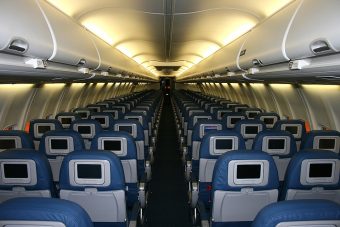Flying is bad for the environment but some airlines are better than others at limiting the damage.

No airline is yet doing enough to reduce carbon emissions in the long term, but Delta (DAL) and United (UAL) are ahead of the pack when it comes to managing their greenhouse gas emissions and the risks related to climate change, according to a new report published on Tuesday.
And Europe’s EasyJet (ESYJY) produces the lowest carbon emissions per kilometer traveled by a passenger, the report also found.
The study by the Grantham Research Institute at the London School of Economics concluded that none of the world’s 20 biggest publicly traded airlines is doing enough to tackle climate change. The research was funded by Transition Pathway Initiative, a group of investors with $13 trillion in assets under management that includes BNP Paribas (BNPQF) and Aviva (AIVAF).
It said that the aviation sector must step up efforts to reduce the amount of greenhouse gases it produces, rather than rely on an offsetting mechanism that allows it to trade carbon emissions with other industries.
In addition to Delta and United, the report called out Germany’s Lufthansa (DLAKY) and Japan’s ANA Group (ALNPY), as having gone the furthest on tackling climate change risks. Australia’s Qantas (QABSY), Alaska Air (ALK) and United scored well on carbon emissions, alongside EasyJet.
But ANA scored badly on that measure, as did Korean Air and Japan Airlines (JAPSY). The report said factors such as the age of fleets, the mix of long and short haul flights, the amount of freight carried and the density of seats would all affect carbon emissions per passenger.
United, Delta, Lufthansa and ANA have taken account of the risks climate change poses to their business in developing their corporate strategies, a step investors are increasingly demanding from companies across different industries.
However, the study said only Delta and Lufthansa have gone as far as linking their climate change targets to executive pay, another common demand from investors.
“The aviation sector is doing the basics when it comes to carbon performance, but investors are urging them to take more significant steps as they judge which airlines are most likely to survive the turbulence of the transition to a low carbon economy,” said Faith Ward, co-chair of the Transition Pathway Initiative.
Korean Air, Southwest (LUV) and American Airlines (AAL) were among the companies identified by the study as lagging behind on climate change strategy and long term targets. However, Southwest scored well on carbon efficiency. American said it was “taking significant steps to reduce its carbon footprint.”
Only one airline on track to meet Paris goals
Some of the world’s biggest airlines were not included in the study. That’s because they are not publicly traded (Qatar Airways and Emirates), or because not enough of their shares are available to foreign investors (Ryanair (RYAAY)).
The study also looked at whether airlines’ current plans for carbon emissions reductions are in line with international pledges, such as the Paris climate accord. It said EasyJet was the only airline on track to meet those benchmarks after 2020.
The airline sector currently accounts for 2% of global CO2 emissions. The International Air Transport Association (IATA) is expecting the number of air travel passengers to double to 8.2 billion by 2037, which could mean higher emissions.
A spokesperson for IATA said the association wants airlines to ramp up investment in new technologies that would make flying more efficient. However, he added that it’s not just up to the airlines to become more efficient.
“The current air traffic control management system is outdated and needs modernizing. That would lead to more efficient routes,” the spokesperson added.
The industry is also arguing that airlines have to rely on offsetting in shorter term because there is no technology that could replace the current fuels — unlike in the automobile industry which can increasingly rely on electrification.
Source: CNN



